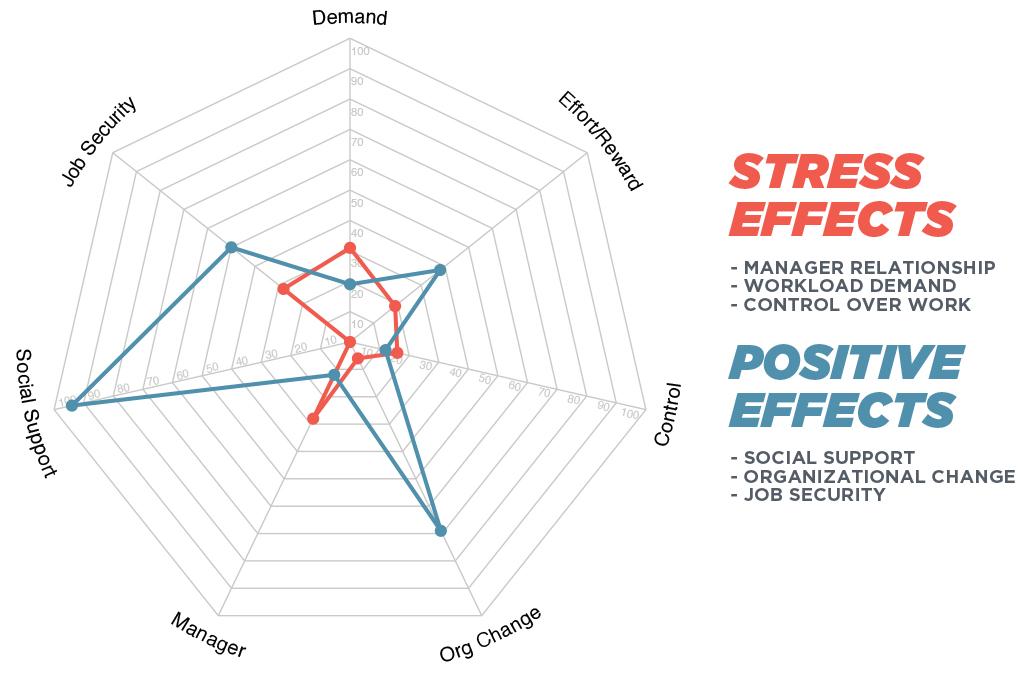


How Do Leaders Address Stress?
Leaders with the power to identify how stress affects the overall health, productivity and morale of the entire organization set themselves apart by doing so. Tackling the causes of stress in individuals and in organizations leads to higher performance, fewer missed days and, most importantly, reinforces your company truly cares for its employees. Start diagnosing stress – and begin creating a healthier, more productive workplace by using TTI SI’s Stress Quotient™.

Is Your Stress Tolerable or at a Tipping Point?
%
Report experiencing at least one stress symptom in the last month
%
Feel depressed or sad due to stress in the last month
%
Say stress has kept them awake at night in the last month
%
Say stress has increased in the past year

1. DEMAND
2. EFFORTS/REWARD BALANCE
3. CONTROL
4. ORGANIZATION CHANGE
5. MANAGER/SUPERVISOR
6. SOCIAL SUPPORT
7. JOB SECURITY
Stress Quotient™: How It Works
What’s the Stress Quotient in YOUR Workplace?
Learn how one manager used Stress Quotient to rebuild the performance, morale and productivity of his team.
Group Stress Index Summary
Like an illness, stress can spread throughout an office and have a controlling effect on team dynamics. As this summary graph shows, stress has greatly impacted the organization (18 employees were surveyed) as 94 percent of the department has elevated and significant stress levels. The Organizational Change Index tells us how stress has a perceived impact on organizational communication, or how policies, procedures and other policies are communicated, as well as achieving change for the future. Stress also has a large, perceived impact on this group’s social support network; 73 percent of respondents believe there is a lack of cooperation and that people are consciously or unconsciously bypassing others or situations that might cause conflict.

Stress Symptoms
Stress can be a positive in our lives, spurring us into action to accomplish tasks. But often, stress is a negative, particularly when faced with continuous challenges we are not equipped to handle. Because we don’t always want to admit we’re stressed in the workplace, it can be a silent killer, as the symptoms aren’t always pronounced. Managing these physical and emotional symptoms allows us to better deal with stress. As this summary graph shows, behavioral stress symptoms, which include eating or sleeping issues, procrastination or other nervous habits, have had an effect on this group and impacted work at this organization. Physical and emotional symptoms, including low energy, frequent illness, irritability and feeling overwhelmed also scored high and are typically of major concern to employers. These stress-related issues tend to fester and impact productivity or one’s ability to show up to work.

Stress Effects Analysis
There’s good stress and bad stress. Good stress gets us up in the morning and allows us to deal with the challenges that help us learn and grow. But what about the bad, debilitating stress? Stress not only impacts us physically and emotionally, but also has a direct effect on how we perceive job security and workplace demands. As this graph matrix shows us, stress is festering for this individual, but it’s not happening at the surface level. In other words, this person likely won’t explode at work due to a buildup of uncontrolled emotions. The stressors impacting this individual include a real or perceived touchy relationship with their manager, as well as moderate concerns about their workload demand and the control they have on their work. The longer these issues go unchecked, the greater the possibility there is for this individual to experience burnout and even heightened stress in these areas.

Stress Factor – Effort/Reward Balance
Job satisfaction stems not only from enjoying the work itself, but also rewards in the form of compensation, benefits and overall satisfaction based on aligned cultural values. When those desires aren’t met and workloads pile up, stress and burnout can build slowly over time, creating a significant disconnect between workplace needs and satisfaction. As this graph shows, this individual views the work as genuinely meaningful, but feels he is not being properly recognized or rewarded for his contribution. Is someone taking credit for his work? Does he believe he’s not getting fairly compensated? Calling attention to this impasse can certainly help lessen the stress this individual has regarding workplace recognition and rewards.

Understanding The Signs of Stress

Physical
Symptoms
The common physical symptoms of stress include:
- Low energy
- Aches and pains
- Frequent illness

Emotional
Symptoms
The common emotional symptoms of stress include:
- Irritability
- Feeling overwhelmed
- Moodiness

Cognitive
Symptoms
The common cognitive symptoms of stress include:
- Inability to concentrate
- Memory problems
- Poor judgment

Behavioral Symptoms
The common behavioral symptoms of stress include:
- Eating or sleeping issues
- Procrastination
- Nervous habits
Get More Data
Download our e-book on 7 things you’ll discover about stress, and share it with your team.
